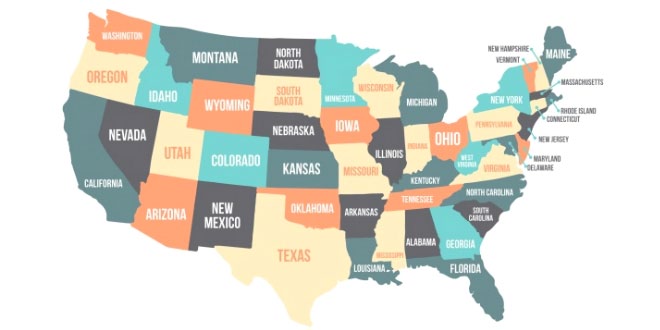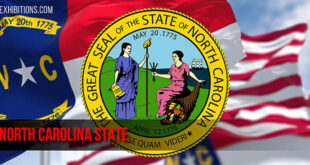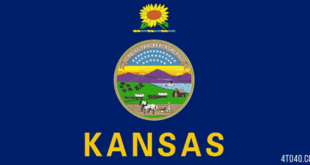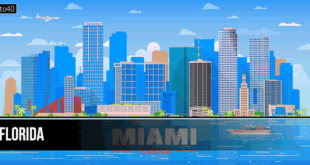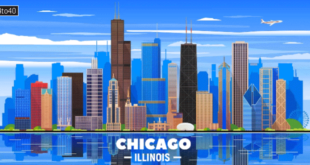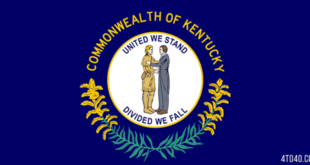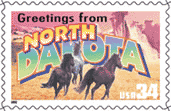 The state ranks 19th in area of the 50 states, and 47th in population (1990 resident census, 638,800). Bismarck, the capital, has a population of 49,256 (1990). The name Dakota comes from a Sioux Indian word meaning “allies”. North Dakota is a significant agricultural producer and contributes lignite coal and petroleum reserves to regional and national demands for increased energy. The state is concerned with maintaining the present quality of the environment while developing its resources.
The state ranks 19th in area of the 50 states, and 47th in population (1990 resident census, 638,800). Bismarck, the capital, has a population of 49,256 (1990). The name Dakota comes from a Sioux Indian word meaning “allies”. North Dakota is a significant agricultural producer and contributes lignite coal and petroleum reserves to regional and national demands for increased energy. The state is concerned with maintaining the present quality of the environment while developing its resources.
North Dakota State: Land & Resources
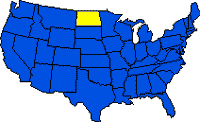 North Dakota State is composed of three principal physiographic regions: the Red River Valley, the Drift Prairie, and the Missouri Plateau. These regions rise from east to west in a steplike fashion from 229 m (750 ft) in the Red River Valley to the state’s highest elevation of 1,069 m (3,506 ft) at White Butte on the Missouri Plateau.
North Dakota State is composed of three principal physiographic regions: the Red River Valley, the Drift Prairie, and the Missouri Plateau. These regions rise from east to west in a steplike fashion from 229 m (750 ft) in the Red River Valley to the state’s highest elevation of 1,069 m (3,506 ft) at White Butte on the Missouri Plateau.
The Red River Valley is the former bed of glacial Lake Agassiz. The North Dakota portion varies from 16 to 64 km (10 to 40 mi) in width from north to south along the North Dakota and Minnesota border. The valley is relatively flat, with an average elevation of 275 m (900 ft). The Drift Prairie lies to the west of the Red River Valley in the center of the state. It is separated from the Red River Valley by the Pembina Escarpment in the north and the Coteau des Prairies in the south. The land is generally hilly, averaging 440 m (1,450 ft) in elevation, and broken by numerous shallow coulees and lakes.
The Missouri Plateau lies to the southwest of the Drift Prairie, separated from it by the Missouri Escarpment and a hilly area between the Missouri River and the escarpment known as the Coteau du Missouri. Elevations average 655 m (2,150 ft), and the land surface is irregular and rolling. The rugged BADLANDS, with rock formations eroded by the Little Missouri River, are found in this area, as are the Killdeer Mountains, with buttes rising about 180 m (600 ft) above the prairie.
Soils vary across the state. In the Red River Valley rich chernozem (black) soils of excellent fertility are prominent. On the Drift Prairie, glacial soils are well suited for agricultural production, especially of wheat and other small grains. The chestnut or brown soils of the Missouri Plateau were formed under semiarid climatic conditions and are less productive than the eastern soils formed under more humid conditions; these chestnut soils are productive with adequate moisture, but agricultural yields are lowered by moisture deficiency.
Climate
The climate of North Dakota ranges from humid-continental in the east to semiarid in the west and is characterized by hot summers and cold winters, low humidity and precipitation, and much wind and sunshine. Precipitation varies from an average of near 560 mm (22 in) in the east to less than 380 mm (15 in) in the southwest. Statewide, one-half of the total precipitation occurs in the months of May, June, and July. Temperatures range from a July average of 21 deg C (70 deg F) to a January average of – 14 deg C (6 deg F). The growing season averages more than 100 days.
Historic Sites
North Dakota’s historic sites reflect the frontier character of the state. Military forts include Fort Lincoln, the post from which Gen. George Custer departed for his fateful encounter at the Little Bighorn. The oldest settlement in North Dakota is at Pembina. The historic cattle town of Medora (est. 1883) in the Badlands of western North Dakota has been reconstructed; Medora symbolizes the era when Theodore Roosevelt ranched in the area and the marquis de Mores, a French nobleman, established a meat-packing plant to supply eastern markets.
Tourism
North Dakota, a large but sparsely populated state, is served by two major interstate highway systems. Interstate 94 travels east and west, passing near Fargo, Jamestown, and Bismarck; Interstate 29 extends north and south near North Dakota’s eastern border. Major railroads servicing North Dakota are the Burlington Northern and the Soo Line. Several airlines provide transportation for the state. Tourists attracted to outdoor activities and exploration provide significant income and employment opportunities.
North Dakota State: History
As long as 15,000 years ago a hunting culture inhabited the region that is now North Dakota. In historic times Indian tribes of the region included the Dakota, usually called SIOUX, a name bestowed on them by others that means “enemies”; the HIDATSA, parent tribe of the CROW nation; the OJIBWA, who came west from the Great Lakes with French trappers; and the CHEYENNE, originally a pastoral people, who became nomadic as they were pushed west by the Sioux. The first European to visit the area was the sieur de LA VERENDRYE, a French fur trapper from Canada. In 1738 he met and lived with the MANDAN Indians near present-day Bismarck.
In 1742, La Verendrye’s sons returned to explore southwestern North Dakota in search of the great western sea. Lewis and Clark explored (1804-05, 1806) the Missouri River through North Dakota on their expedition to the Pacific and again on their return in 1806 (see LEWIS AND CLARK EXPEDITION). In 1812 colonists sponsored by the earl of SELKIRK arrived at Pembina as part of the larger RED RIVER SETTLEMENT. This first attempt to establish a permanent European settlement in the state failed, but Charles Cavaleer brought settlers to Pembina from Minnesota to form the first permanent agricultural colony in 1851.
The period from 1850 to 1870 was one of war with the Dakota Indians, who were being pushed west by European settlers in Minnesota and whose bison herds on the Dakota plains were being decimated. The Dakota Indians were eventually pushed into the Badlands, west of the Missouri River, and the Dakota Territory was opened to homesteading on Jan. 1, 1863. Joseph Rolette filed the first homestead in the northwestern Red River Valley in 1868. In 1871 railroads reached the Red River of the North from Duluth and Saint Paul, resulting in the emergence of Fargo, now the state’s largest city. A flood of settlers homesteaded the area, and large-scale agriculture began. The period from 1878 to 1886 became known as the Dakota Boom, but settlement west and north of the Missouri River was stalled until the surrender of SITTING BULL, chief of the Sioux, at Fort Buford in 1881. North Dakota became the 39th state on Nov. 2, 1889.
Agriculture has grown dramatically since World War II and remains the mainstay of the state’s economy. Resource development was highlighted in 1957 by the discovery of oil. The strategic importance of the state was enhanced during the 1960s by the establishment of air bases and intercontinental ballistic missile sites.
The energy crisis of the 1970s spurred increased exploration and development of the state’s oil resources and the mining of its immense lignite reserves. The development of water projects in this area of variable precipitation remains a vital concern from the standpoints of environmental impact and economic benefit to the agricultural sector.
North Dakota is a large state with a small population. The rural character of its people is manifest in their independence and self-reliance. The people judiciously guard their quality of life. As a producer of agricultural and energy commodities, the state will experience increasing demand for its products. The consequences of this demand, as reflected by agricultural commodity prices, economic stability, and quality of the natural and human environment, are the paramount concerns of the present.
https://www.youtube.com/watch?v=KwcksvgBKek
North Dakota State: Land
- Area: 183,123 sq km (70,704 sq mi); rank: 19th.
- Capital: Bismarck (1990 pop., 49,256).
- Largest city: Fargo (1990 pop., 74,111).
- Counties: 53.
- Elevations: highest–1,069 m (3,506 ft), at White Butte; lowest–229 m (750 ft), at the Red River.
North Dakota State Symbols
Flag:

Statehood:
Nov. 2, 1889; the 39th state
Nickname:
Flickertail State and Sioux State;
Bird:
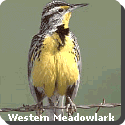
Tree:
American Elm
Flower:
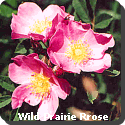
 Kids Portal For Parents India Kids Network
Kids Portal For Parents India Kids Network
